Physical Address
304 North Cardinal St.
Dorchester Center, MA 02124
In the last decades, immunohistochemistry (IHC) has seen a marked expansion in application to the diagnosis and prognosis of lesions of the female genital tract. In this chapter, I concentrate on the diagnostic utility of IHC markers in gynecologic pathology as markers of prognostic and predictive significance have been discussed in previous chapters. The uses of immunohistochemistry are covered at the various sites within the female genital tract, with an emphasis on the most useful panels of markers in various diagnostic situations. It is emphasized that selecting a panel, rather than individual markers, should be preferred in most instances since there is always the potential for immunophenotypic overlap and for unexpected positive and negative staining reactions.
A summary of the most common markers used in gynecologic pathology practice is presented in Table 20.1 . In terms of reporting of immunohistochemical results, there are some important considerations. p53 staining is useful in various diagnostic scenarios, and it is stressed that it is no longer appropriate to consider p53 staining as positive or negative. Instead, p53 staining is referred to as 1) “abnormal” or “mutation type” (pattern of staining that is highly predictive of underlying Tp53 mutation) or 2) “normal” or “wild type” (pattern of staining not predictive of underlying Tp53 mutation). There are two major patterns of abnormal p53 staining often referred to as “all or nothing staining”: diffuse intense staining involving greater than 80% of tumor cell nuclei or completely negative staining of tumor cell nuclei (associated with a positive internal control in the form of weak staining of a proportion of nonneoplastic cells, for example, stromal or lymphoid cells). A third abnormal pattern, infrequently encountered, is cytoplasmic staining. In contrast, “wild-type staining” comprises focal and heterogeneous staining of variable intensity of less than 80% of tumor cell nuclei. Accurate reporting of results from other markers may require avoiding the classic “positive” or “negative” narrative, since these terms may not actually reflect the underlying mechanism and cause confusion. A good example is markers in which the significant result is loss of expression, such as mismatch repair proteins, PTEN, ARID1A, SMARCA4, and BAP1. The significant result should be reported as “loss” (abnormal) versus “retained” (normal).
| Reporting | |||||
|---|---|---|---|---|---|
| Marker | Expression | Terminology | Example a | Terminology | Example a |
| AFP | Cytoplasmic | Positive | Ovarian yolk sac tumor | Negative | Ovarian dysgerminoma |
| AMACR | Cytoplasmic | Positive | Clear cell carcinoma | Negative | Serous carcinoma |
| ARID1A | Nuclear | Lost | Clear cell carcinoma, endometrioid carcinoma | Retained | Serous carcinoma |
| BAP1 | Nuclear | Lost | Malignant mesothelioma | Retained | Reactive mesothelium |
| Beta-catenin | Nuclear | Positive b | Microcystic stromal tumor | Negative | Granulosa cell tumor |
| BCOR | Nuclear | Positive | BCOR-altered high-grade endometrial stromal sarcoma | Negative | Low-grade endometrial stromal sarcoma |
| Caldesmon | Cytoplasmic/membranous | Positive | Smooth muscle tumors | Negative | Endometrial stromal sarcoma |
| Calretinin | Cytoplasmic | Positive | Ovarian sex cord-stromal tumors | Negative | Smooth muscle tumors |
| Cathepsin K | Cytoplasmic (granular) | Positive | Perivascular epithelioid cell tumor | Negative | Smooth muscle tumors |
| CD10 | Cytoplasmic/membranous | Positive | Low-grade endometrial stromal sarcoma | Negative | Smooth muscle tumors |
| CD30 | Cytoplasmic/membranous | Positive | Ovarian embryonal carcinoma | Negative | Ovarian yolk sac tumor |
| Cyclin D1 | Nuclear | Positive | High-grade endometrial stromal sarcoma | Negative | Low-grade endometrial stromal sarcoma |
| Desmin | Cytoplasmic | Positive | Smooth muscle tumors | Negative | Endometrial stromal sarcoma |
| ER | Nuclear | Positive c | Endometrial endometrioid carcinoma | Negative | Mesonephric carcinoma |
| FOXL2 | Cytoplasmic | Positive | Ovarian sex cord-stromal tumors | Negative | Endometrioid stromal sarcoma |
| GATA3 | Nuclear | Positive | Mesonephric carcinoma; trophoblastic proliferations | Negative | Müllerian carcinoma |
| Glypican 3 | Cytoplasmic | Positive | Ovarian yolk sac tumor | Negative | Ovarian dysgerminoma |
| hCG | Cytoplasmic | Positive | Choriocarcinoma | Negative | Serous carcinoma |
| HIK1083 | Cytoplasmic | Positive | Gastric-type endocervical adenocarcinoma | Negative | HPV-related endocervical adenocarcinoma |
| HLA-G | Cytoplasmic | Positive | Trophoblastic proliferations | Negative | Normal endometrium |
| HMB45 | Cytoplasmic | Positive | Uterine perivascular epithelioid cell tumor | Negative | Smooth muscle tumors |
| HMGA2 | Nuclear | Positive | Vulvar aggressive angiomyxoma | Negative | Superficial angiomyxoma |
| HNF1B | Nuclear | Positive | Clear cell carcinoma | Negative | Endometrioid carcinoma |
| hPL | Cytoplasmic | Positive | Placental site trophoblastic tumor | Negative | Endometrial carcinoma |
| IFITM1 | Membranous/cytoplasmic | Positive | Endometrial stromal sarcoma | Negative | Smooth muscle tumors |
| IMP3 | Nuclear | Positive | Endometrial serous carcinoma | Negative | Endometrial endometrioid carcinoma |
| Inhibin | Cytoplasmic | Positive | Ovarian sex cord-stromal tumors | Negative | Smooth muscle tumors |
| INI1/SMARCB1 | Nuclear | Lost | Vulvo-vaginal epithelioid sarcoma, proximal type | Retained | Smooth muscle tumors |
| Ki67/MIB1 | Nuclear | Positive d | Placental site trophoblastic tumor (>1%) | Negative | Exaggerated placental site (≤1%) |
| mCEA | Membranous/cytoplasmic | Positive | Primary endocervical adenocarcinoma | Negative | Primary endometrial endometrioid carcinoma |
| Melan-A | Cytoplasmic | Positive | Melanoma; uterine perivascular epithelioid cell tumor | Negative | Smooth muscle tumors |
| MelCAM | Membranous | Positive | Placental site trophoblastic tumor | Negative | Endometrial carcinoma |
| MiTF | Nuclear | Positive | Uterine perivascular epithelioid cell tumor | Negative | Smooth muscle tumors |
| Myogenin | Nuclear | Positive | Rhabdomyosarcoma/rhabdomyosarcomatous differentiation | Negative | Smooth muscle tumors |
| Myoglobin | Cytoplasmic | Positive | Rhabdomyosarcoma/rhabdomyosarcomatous differentiation | Negative | Smooth muscle tumors |
| Napsin-A | Cytoplasmic | Positive | Clear cell carcinoma | Negative | Serous carcinoma; endometrioid carcinoma |
| OCT4 | Nuclear | Positive | Ovarian dysgerminoma | Negative | Ovarian yolk sac tumor |
| p16 | Nuclear/cytoplasmic | Overexpressed e | HSIL (u-VIN III, VAIN3, CIN3); HPV-related cervical adenocarcinoma | Negative/patchy f | dVIN, gastric-type endocervical adenocarcinoma |
| p40 | Nuclear | Positive | Squamous cell carcinoma | Negative | Adenocarcinoma |
| p53 | Nuclear | Abnormal g | Tubo-ovarian high-grade serous carcinoma | Normal h | Low-grade serous carcinoma |
| p57 | Nuclear | Lost | Complete hydatidiform mole | Retained | Partial mole; nonmolar gestation |
| p63 | Nuclear | Positive | Squamous cell carcinoma | Negative | Adenocarcinoma |
| PAX8 | Nuclear | Positive | Müllerian carcinoma | Negative | Metastatic colorectal carcinoma to ovary |
| PR | Nuclear | Positive c | Primary endometrial endometrioid carcinoma | Negative | Primary endocervical adenocarcinoma |
| PTEN | Cytoplasmic | Lost | Endometrioid carcinoma | Retained | Serous carcinoma |
| S100 | Nuclear/cytoplasmic | Positive | Melanoma | Negative | Paget disease |
| SALL4 | Nuclear | Positive | Ovarian yolk sac tumor | Negative | Endometrioid carcinoma |
| SATB2 | Nuclear | Positive | Metastatic colorectal carcinoma to ovary | Negative | Primary ovarian mucinous carcinoma |
| SF1 | Nuclear | Positive | Ovarian sex cord-stromal tumors | Negative | Endometrioid carcinoma |
| SMA | Cytoplasmic | Positive | Smooth muscle tumors | Negative | Prepubertal vulvar fibroma |
| SMAD4 | Nuclear | Lost | Metastatic pancreatic carcinoma to ovary | Retained | Primary ovarian mucinous carcinoma |
| SMARCA4 | Nuclear | Lost | Ovarian small cell carcinoma, hypercalcemic type | Retained | Neuroendocrine carcinoma |
| SOX10 | Nuclear | Positive | Melanoma | Negative | Paget disease |
| STAT6 | Nuclear | Positive | Solitary fibrous tumor | Negative | Ovarian fibroma |
| Synpatophysin | Cytoplasmic | Positive | Neuroendocrine carcinoma | Negative | Endometrioid carcinoma |
| Thyroglobulin | Cytoplasmic | Positive | Struma ovarii | Negative | Primary ovarian mucinous carcinoma |
| TTF1 | Nuclear | Positive | Struma ovarii, gynecologic neuroendocrine carcinoma | Negative | Primary ovarian mucinous carcinoma |
| Vimentin | Membranous/cytoplasmic | Positive | Primary endometrial endometrioid carcinoma | Negative | Primary endocervical adenocarcinoma |
| WT1 | Nuclear | Positive | Tubal epithelium; tubo-ovarian serous carcinoma | Negative | Endometrial serous carcinoma |
a The examples provided correspond to entities in which a significant number of cases have the corresponding result, paired with a common differential diagnosis with a predominantly opposite expression pattern. In most, if not all, of these examples, there can be unexpected expression patterns.
b Strong cytoplasmic and membranous beta-catenin expression is ubiquitous in many cell types and should not be counted.
c Routine quantification of positive cells, in terms of percentage of the total cell population, is recommended. Other methods, such as H-score and Allred score, are valid alternatives.
d Routine quantification of positive cells, in terms of percentage of the total cell population, is recommended.
e Significant p16 expression is defined as strong nuclear and cytoplasmic staining; in squamous epithelium, this staining should be seen continuously in essentially all of the basal epithelium of the abnormal area (“block” staining).
f Patchy p16 staining is defined as staining of heterogeneous intensity, with negative and weakly positive cells admixed; staining is mostly cytoplasmic.
g Abnormal p53 staining is defined as strong nuclear expression in ≥80% of cells, complete absence of staining, or cytoplasmic staining.
h Normal p53 staining is defined as heterogeneous staining throughout cells (with negative and weakly positive cells admixed).
Routine molecular diagnostics is only at its early stages in the field of gynecologic pathology. There are, nonetheless, several scenarios in which molecular analysis has an established role in the differential diagnosis or offers important diagnostic and prognostic information. These scenarios are also discussed in this chapter.
In the vulva, the morphologic hallmarks of human papillomavirus (HPV) infection, such as koilocytosis, may not be as well developed as in the cervix, and therefore, it may be difficult to diagnose a viral-associated lesion. In equivocal cases, in which the diagnosis of low-grade squamous intraepithelial lesion (LSIL)/VIN I is suspected, immunohistochemical staining with the proliferation marker Ki67 may be of value as these low-grade vulvar lesions are characterized by Ki67-positive nuclei in the middle and upper thirds of the epithelium, which contrasts with reactive epithelium where the positivity is typically confined to the basal and parabasal nuclei. Ki67 staining may also be useful in confirming high-grade squamous intraepithelial lesion (HSIL)/VIN II to III of the usual (human papillomavirus [HPV]-related) type, as the nuclei of HSIL express Ki67 throughout much of the full epithelial thickness ( Fig. 20.1A ). This expression pattern is useful in the separation of high-grade lesions from atrophic squamous epithelium, which is predominantly negative. ProExC (a cocktail of topoisomerase II alpha and minichromosome maintenance 2 proteins) has similar applications to Ki67 but appears to have better specificity and lower background staining. Increased levels of the cyclin-dependent kinase inhibitor p16 are frequently seen in the context of active oncogenic HPV infection, secondary to the presence of E7 viral oncoprotein which inactivates Rb, leading to disruption of the negative feedback loop of p16. Consequently, p16 is used as a marker of HPV infection in the lower anogenital tract. This marker is typically “overexpressed” in HSIL with the so-called “block” immunoreactivity, defined as continuous intense nuclear and cytoplasmic staining of at least one-third of the epithelial thickness ( Fig. 20.1B ). Such staining pattern is not observed in nonneoplastic squamous epithelium.
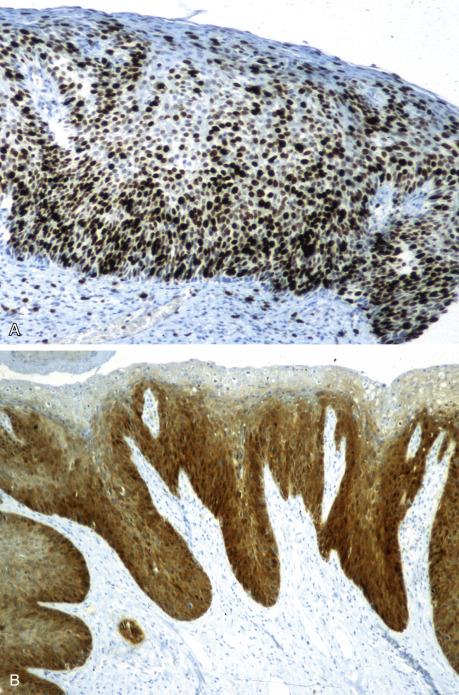
Immunohistochemistry may also assist in the diagnosis of differentiated VIN (dVIN, HPV-negative), which can be difficult since the morphologic features may be subtle. dVIN is negative for p16 overexpression. “Mutation-type” staining for p53 (totally negative staining or diffuse intense staining in the basal and suprabasal cells) is a feature of most, but not all, cases of dVIN ( Fig. 20.2 ). This may be helpful in distinguishing dVIN from nonneoplastic squamous epithelium and in ascertaining the margin status of dVIN. However, as not all cases of dVIN exhibit “mutation-type” p53 immunoreactivity, and nonneoplastic vulvar squamous epithelium (lichen sclerosus, lichen simplex chronicus) can show p53 overexpression, the staining pattern must always be interpreted considering the morphologic features.
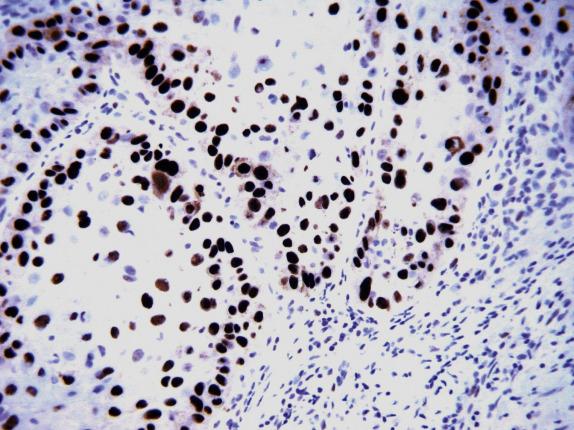
There are two types of vulvar squamous carcinoma: HPV associated and non–HPV associated. Although most HPV-related neoplasms have a basaloid appearance and are nonkeratinizing, and most HPV-unrelated squamous carcinomas are well differentiated and keratinizing, there can be morphologic overlap. The distinction between the two has prognostic importance, as the latter shows more aggressive behavior (local recurrence, metastatic spread). p16 staining is useful in confirming an HPV-related neoplasm (diffuse, “block” positivity) and an HPV-unrelated tumor (negative or focally positive) ( Fig. 20.3A ). p53 may also be of value since some HPV-unrelated neoplasms exhibit “mutation-type” staining whereas HPV-related tumors typically exhibit wild-type staining ( Fig. 20.3B ).
p16: Overexpression (“block” type immunoreactivity) in HSIL/usual VIN II–III
p16 negative or patchy staining in dVIN, nonneoplastic squamous epithelium and LSIL/VIN I (the latter with exceptions)
Ki67 positivity in upper epithelial layers in LSIL or HSIL
Ki67 staining limited to basal/parabasal layers in dVIN, atrophy, and other nonneoplastic squamous epithelium.
p53 shows abnormal expression in differentiated VIN (exceptions occur)
p53 shows normal expression in, LSIL, and most nonneoplastic squamous epithelium (lichen sclerosus and other benign conditions may show p53 overexpression)
p16 overexpression in HPV related carcinoma
p16 negative or patchy in HPV unrelated carcinoma
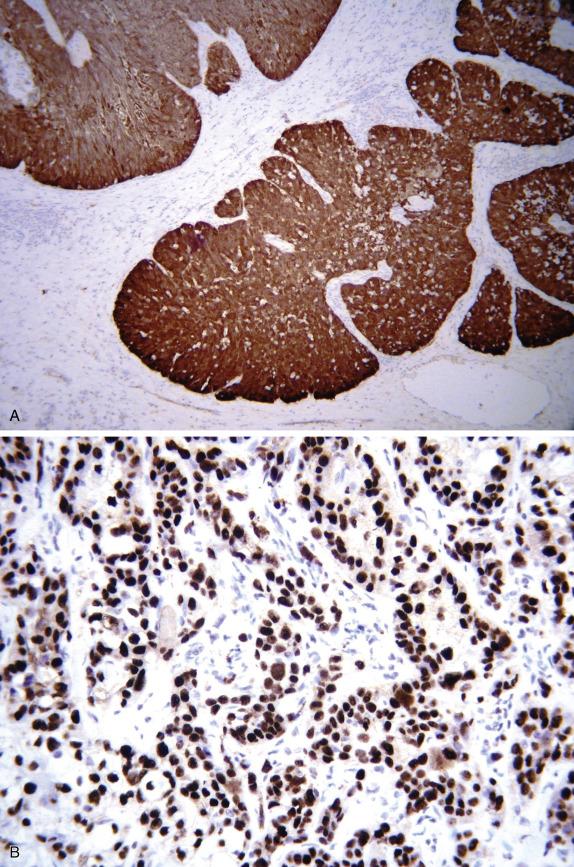
Immunohistochemistry may be of value in establishing the diagnosis of Paget disease involving the vulva when only small numbers of neoplastic cells are present; it is also useful in the distinction from its mimickers and in determining whether it is primary vulvar Paget disease or secondary to spread from an internal organ such as the colorectum or urinary bladder. The cells of primary vulvar Paget disease are typically positive with CAM5.2, CK7, epithelial membrane antigen (EMA), and carcinoembryonic antigen (CEA) ( Fig. 20.4 ). This helps to exclude mimics such as pagetoid dVIN or HSIL, melanocytic lesions, and mycosis fungoides, which are usually negative for these markers, although there are occasional exceptions. The cells of primary vulvar Paget disease are also often positive for GATA3, androgen receptor, HER2, and GCDFP-15. The various markers help to confirm the diagnosis and may also be useful in the determination of margin status and in identifying small foci of dermal invasion. Although primary vulvar Paget disease may show focal CK20 staining, diffuse positivity for this marker raises the possibility of spread from an internal organ such as the colorectum or urinary bladder, as primary carcinomas in these sites are commonly CK20 positive. Paget disease secondary to spread from a urinary bladder carcinoma is also commonly positive for uroplakin-III and GATA3, whereas that secondary to a colorectal adenocarcinoma is CDX2 positive. p16 is commonly positive in primary vulvar Paget disease; this is important in that when the cells of Paget disease are confluent, HSIL may be a diagnostic consideration; in such cases, positive staining with p16 may result in misdiagnosis as HSIL.
Primary vulvar Paget disease: CAM 5.2, CK7, EMA, CEA, GATA3, and GCDFP-15 typically positive; may be p16 positive
Paget disease secondary to a urothelial carcinoma: CK7, CK20 (strong, diffuse), GATA3, and uroplakin-III typically positive
Paget disease secondary to spread from a colorectal primary: CK20, CDX2, and CEA typically positive
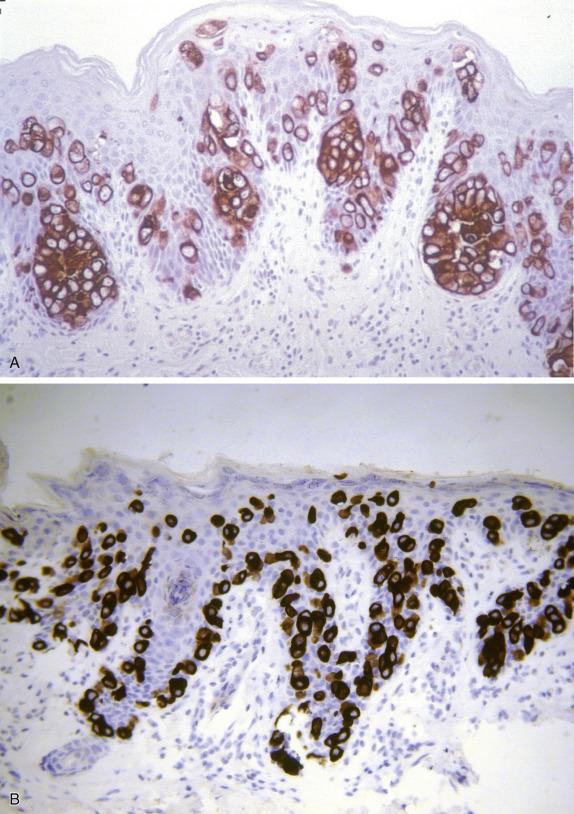
Most of the relatively site-specific vulvovaginal mesenchymal lesions are positive for estrogen receptor (ER), progesterone receptor (PR), desmin, and CD34, and thus immunohistochemistry is of limited value in distinguishing between the various entities. However, it may be useful in the diagnosis of cellular angiofibroma since this is usually, although not always, negative for desmin (and SMA), and in the diagnosis of superficial angiomyxoma, which tends to be negative for ER and PR. In addition, loss of RB expression is seen in cellular angiofibroma, mammary-type myofibroblastoma, and spindle cell lipoma and this marker is useful in distinguishing these tumors from other vulvovaginal mesenchymal lesions.
Immunohistochemical staining with HMGA2 may be of value in the diagnosis of aggressive angiomyxoma, which usually exhibits nuclear positivity with this marker ( Fig. 20.5 ). Most of the other vulvovaginal mesenchymal lesions are negative, except for smooth muscle neoplasms, which are commonly positive. Staining with HMGA2 may also be of value in the assessment of margins in resection specimens of aggressive angiomyxoma and in establishing the presence or absence of residual disease in wider excision specimens, since native vulvovaginal mesenchyme is negative for this marker.
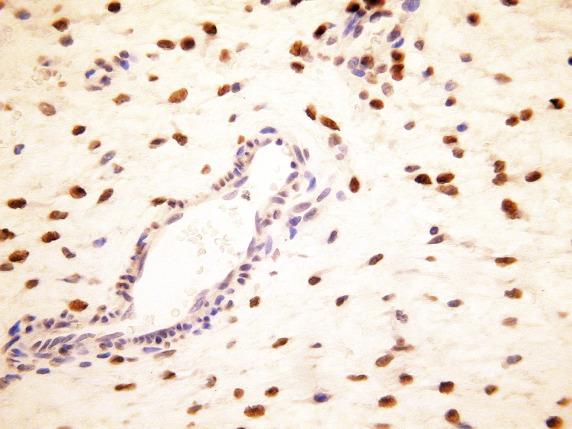
A group of vulvar mesenchymal neoplasms exists that are variably categorized as malignant rhabdoid tumor, classic or proximal epithelioid sarcoma, or myoepithelial neoplasm and that exhibit loss of nuclear staining with INI1 (SMARCB1).
Most of the site-specific vulvovaginal mesenchymal lesions share immunohistochemical profiles, being positive for CD34, desmin, ER, and PR.
Cellular angiofibroma, unlike other mesenchymal tumors at this site, is usually negative for smooth muscle markers and will show loss of expression for Rb.
Superficial angiomyxoma is negative for ER and PR.
HMGA2 may be useful in the distinction of aggressive angiomyxoma from other mesenchymal tumors.
INI1 (SMARCB1)-deficient tumors (so-called malignant rhabdoid tumors, proximal epithelioid sarcoma) may occur in the vulva and vagina.
There is considerable inter- and intraobserver variability in the diagnosis and classification of preinvasive cervical squamous lesions. The proliferation marker Ki67 may be of value in distinguishing LSIL/CIN1 from normal squamous epithelium and benign squamous proliferations. Positive nuclear staining with Ki67 in the upper layers of the epithelium, present in clusters or diffusely, supports the histologic impression of LSIL, as this pattern of staining is not generally seen in benign or reactive lesions. Probably the main utility of Ki67 is the distinction of HSIL/CIN2–3 from mimics such as atrophic squamous epithelium, transitional metaplasia, and immature squamous metaplasia. HSIL exhibits a high Ki67 proliferation index with near full-thickness nuclear positivity ( Fig. 20.6A ). In contrast, atrophic squamous epithelium, transitional metaplasia, and immature squamous metaplasia exhibit a much lower Ki67 proliferation index. Ki67 may also assist in the evaluation of cauterized cervical resection margins, by distinguishing cauterized HSIL from cauterized nondysplastic cervical squamous epithelium. ProExC has similar indications to Ki67.
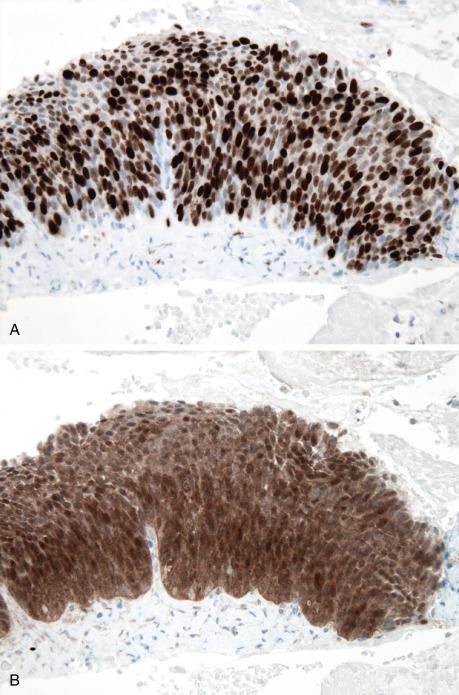
The Lower Anogenital Squamous Lesions Terminology guidelines advocate for p16 as a useful tool to distinguish HSIL from its mimics. The majority of HSIL in the cervix show overexpression of p16 ( Fig. 20.6B ). Nonneoplastic mimics of HSIL, such as atrophic squamous epithelium, transitional metaplasia, and immature squamous metaplasia, are negative or patchy positive (overexpression in only ∼2% of cases). In the distinction between HSIL and LSIL, p16 has a more limited role, as it has been demonstrated that a subset of LSIL in the cervix does arise in the squamous-columnar junction reserve cell epithelium and frequently harbors high-risk HPV. In a large meta-analysis, 38% of reported cervical LSIL showed p16 overexpression. Nonetheless, a negative or patchy p16 staining helps to exclude HSIL.
p16 is overexpressed (“block” type immunoreactivity) in HSIL/CIN2–3
p16 is negative of patchy positive in non-neoplastic squamous epithelium and ∼60%–75% LSIL/CIN1 (overexpression in ∼25%–40%)
Ki67 is positive in the upper epithelial layers of LSIL or HSIL
Ki67 staining is limited to basal/parabasal layers in atropy and other nonneoplastic squamous epithelium
ProExC has similar use as Ki67 (higher specificity and lower background staining)
The distinction between cervical adenocarcinoma in situ (AIS) and benign mimics, including tuboendometrioid metaplasia (TEM), endometriosis, and microglandular hyperplasia (MGH), may be problematic. A panel of markers, including Ki67, bcl-2, and p16, may assist in difficult cases. AIS generally exhibits a high Ki67 proliferation index, usually ≥30% and often much higher ( Fig. 20.7A ). In contrast, most benign endocervical glandular lesions exhibit a low proliferation index (<30%). However, sometimes, there is overlap, with occasional cases of AIS exhibiting a low Ki67 proliferation index and some benign endocervical glandular lesions, especially endometriosis, exhibiting a proliferation index of >30%. Almost all cases of HPV-related AIS exhibit p16 overexpression, which in the glandular epithelium is defined as nuclear and cytoplasmic, strong and continuous staining ( Fig. 20.7B ), whereas benign mimics are typically negative or patchy ( Fig. 20.8A ). It is important to note that a minority of AIS display a gastric phenotype (gastric-type AIS); these lesions are unrelated to HPV like their invasive counterparts and therefore are more likely to have a negative p16 staining pattern. TEM and endometriosis also typically exhibit diffuse cytoplasmic positivity for bcl-2 ( Fig. 20.8B ), whereas AIS is generally negative. Monoclonal CEA (mCEA), vimentin, and ER may also be of value in the distinction between AIS (usually cytoplasmic positivity with mCEA; negative with vimentin and ER) and TEM and endometriosis (negative or focal luminal positivity with mCEA; vimentin and ER positive) ( Fig. 20.8C ). IMP3 is overexpressed in premalignant and malignant endocervical glandular lesions compared to benign lesions. Furthermore, loss of paired box 2 (PAX2) nuclear staining has been demonstrated in AIS and most invasive endocervical adenocarcinomas. The various markers discussed earlier may be of use in the evaluation of cauterized glandular epithelium at cervical loop resection margins if the staining pattern of the AIS is known (for instance, by observing noncauterized areas or staining a different block or specimen).
AIS, usual (HPV-associated) type usually exhibits a high Ki67 proliferation index, diffuse “block” type immunoreactivity with p16, cytoplasmic positivity for mCEA, and is negative for bcl-2, ER, and vimentin.
AIS, gastric type is negative for p16.
TEM and endometriosis usually exhibit a low Ki67 proliferation index, diffuse positivity with ER, vimentin, and bcl-2 and are mCEA negative; p16 is usually negative or focally positive.
MGH is usually ER positive and p16 and bcl-2 negative and exhibits a low Ki67 proliferation index.
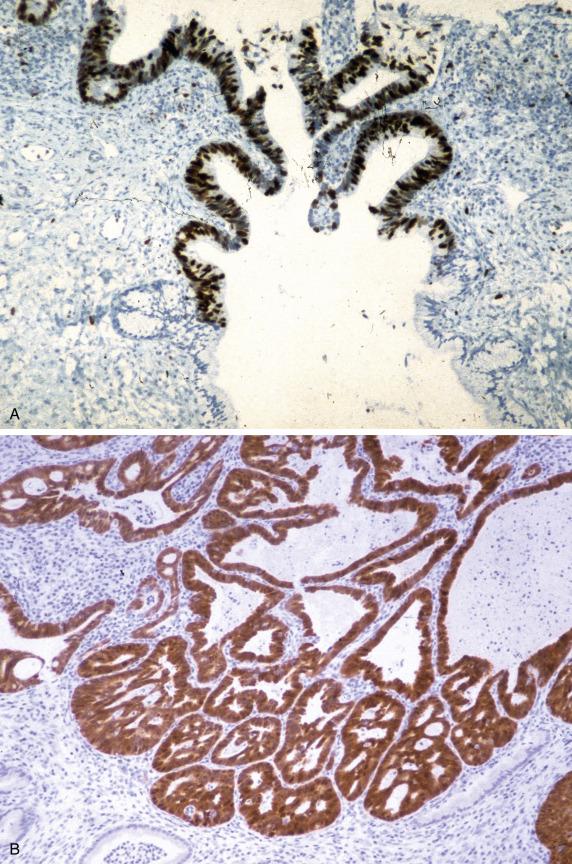
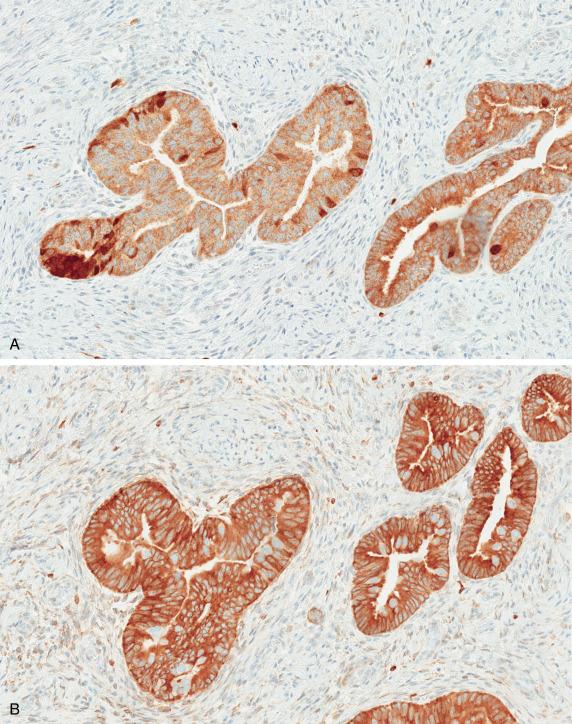
Mesonephric remnants are common within the cervix and, especially when hyperplastic, may be confused with other benign endocervical glandular lesions or a variety of adenocarcinoma types, including mesonephric adenocarcinoma. CD10 is a useful immunohistochemical marker of cervical mesonephric lesions, both benign and malignant, although mesonephric adenocarcinomas are less likely to be positive. There is characteristically luminal positivity with CD10 in cervical mesonephric remnants, although immunoreactivity may be focal ( Fig. 20.9A ). Most other benign endocervical glandular lesions are CD10 negative but some cervical adenocarcinomas of usual (HPV-related) and other morphologic subtypes are positive; thus, this marker is of limited value in confirmation of a mesonephric origin of an adenocarcinoma. Other markers that may be positive in cervical mesonephric lesions are vimentin, calretinin, GATA3, and androgen receptor. GATA3 is a particularly useful marker of mesonephric lesions since most benign mesonephric remnants are positive with nuclear immunoreactivity ( Fig. 20.9B ). Immunoreactivity is less consistent in mesonephric adenocarcinoma: most cases are positive, albeit staining may be focal. ER and PR are usually completely negative in benign and malignant mesonephric proliferations, which is most helpful in distinguishing them from benign cervical proliferations and low-grade endometrial carcinoma, but not from endocervical glandular neoplasia, which is typically hormone receptor negative. Mesonephric lesions, benign and malignant, usually lack p16 overexpression. A variety of other markers may be positive in mesonephric adenocarcinomas, including EMA, calretinin, inhibin, PAX8, HMGA2, CA125, TTF1, and hepatocyte nuclear factor 1 beta (HNF-B); however, these markers are of limited value in diagnosis. There are no IHC markers that assist in the distinction between benign and malignant mesonephric proliferations.
Mesonephric remnants, hyperplasia, and to a lesser extent, adenocarcinomas exhibit luminal staining for CD10
GATA3 is a particularly useful marker of benign mesonephric remnants and carcinoma (most)
Mesonephric lesions may be positive for vimentin, calretinin, androgen receptor, inhibin, EMA, CA125, PAX8, TTF1, HMGA2, and HNF-B
ER and PR are negative (as opposed to benign endocervical proliferations and low-grade endometrial carcinoma)
HPV ISH/polymerase chain reaction (PCR) analyses are negative
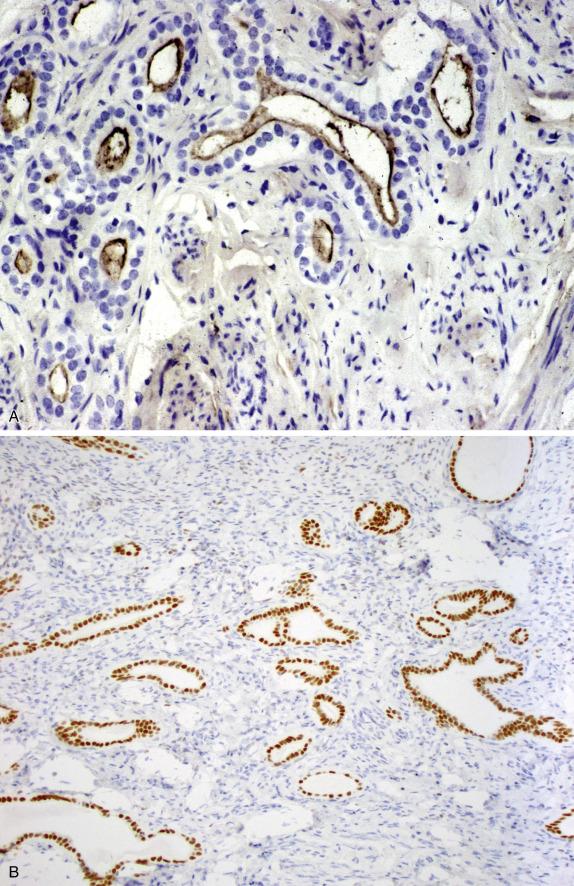
Gastric-type adenocarcinomas of the cervix are not related to HPV infection. The well-differentiated end of the spectrum is termed adenoma malignum (mucinous variant of minimal-deviation adenocarcinoma); less differentiated forms are referred to as gastric-type adenocarcinoma (not otherwise specified). These adenocarcinomas exhibit positive staining with gastric markers, such as HIK1083, MUC6, and carbonic anhydrase IX, although positive staining is often focal ( Fig. 20.10A ). MUC6 is nonspecific as it is seen in other types of adenocarcinoma and benign endocervical epithelium, whereas HIK1083 is relatively specific ( Fig. 20.10B ). Unlike HPV-related adenocarcinomas, gastric-type endocervical adenocarcinomas are typically p16 negative or focally positive and have abnormal p53 expression in ∼50% of cases ( Fig. 20.10C ), although p16 overexpression has been reported in a minority of cases. In the context of p16 overexpression in a tumor with gastric features, HPV detection studies should be considered. CEA is often positive with cytoplasmic immunoreactivity. ER and PR are usually completely negative. Several benign endocervical glandular lesions, including lobular endocervical glandular hyperplasia and some type-A tunnel clusters, also exhibit gastric differentiation and are positive for HIK1083, MUC6, and carbonic anhydrase IX.
Benign and malignant endocervical glandular lesions exhibiting gastric differentiation: characteristically HIK1083, MUC6, and carbonic anhydrase IX positive
Gastric-type adenocarcinomas of the cervix: ER/PR negative, p16 negative or patchy (rarely, overexpressed), and p53 abnormal (∼50% cases, if present it excludes HPV-related adenocarcinoma and benign mimics)
HPV ISH/PCR analyses are negative
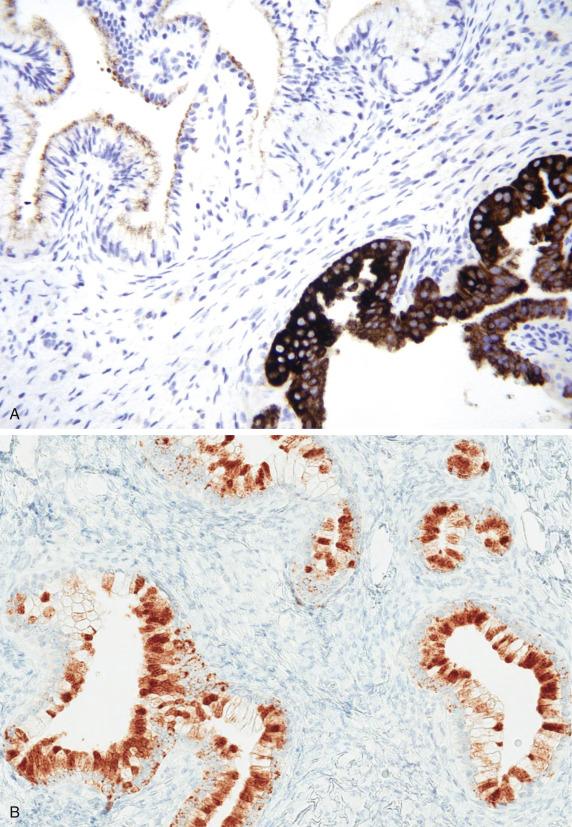
Difficulty in the distinction between primary endocervical adenocarcinoma and low-grade endometrial carcinoma (endometrioid or mucinous) is not uncommon and particularly problematic in biopsy material. Establishing the site of origin is of considerable importance, since cervical carcinomas are usually treated with radical hysterectomy or primary chemoradiation. Surgery, usually simple hysterectomy or sometimes modified radical hysterectomy when tumor involves the cervix, is the treatment of choice for endometrial carcinomas. Occasionally, even in the hysterectomy specimen, it is difficult to ascertain whether a tumor has arisen in the endometrium or cervix, and the decision whether to give adjuvant therapy and the nature of this may depend on the distinction.
ER: Diffusely and strongly positive (>10%) in endometrial endometrioid carcinoma versus negative or patchy (< 10%) in endocervical adenocarcinoma
p16: Negative or patchy in endometrial endometrioid carcinoma versus overexpressed in endocervical adenocarcinoma
Vimentin: Multifocal to diffuse staining in endometrial endometrioid carcinoma versus negative to very focal staining in endocervical adenocarcinoma
mCEA: Negative or apical staining in in endometrial endometrioid carcinoma versus positive cytoplasmic staining in endocervical adenocarcinoma
ER, p16, vimentin, and mCEA of limited value
p53: Abnormal in most serous carcinomas and in some high-grade endometrioid carcinomas, endometrial undifferentiated carcinomas, and gastric-type endocervical adenocarcinomas versus normal in HPV-related endocervical adenocarcinomas
HPV (ISH, PCR): Positive in HPV-related endocervical adenocarcinoma
In the distinction between an HPV-related cervical adenocarcinoma and a low-grade endometrial endometrioid adenocarcinoma, a panel of antibodies comprising ER, vimentin, CEA, and p16 may be of value, although in some cases, there is immunohistochemical overlap ( Table 20.2 ). Low-grade endometrioid adenocarcinomas usually exhibit diffuse nuclear positivity for ER ( Fig. 20.11A ) and diffuse to multifocal cytoplasmic immunoreactivity for vimentin ( Fig. 20.11B ); in turn, p16 is negative or shows focal positivity; staining can be quite strong, but not diffuse/continuous, and often only cytoplasmic, giving a “mosaic” or heterogeneous appearance. mCEA has negative or only apical staining in low-grade endometrioid carcinoma; however, it is less reliable compared to the other markers in the panel. Squamous elements, which are commonly seen in adenocarcinomas of endometrioid type, are often positive for both CEA and p16 and should not be included in the interpretation of the staining patterns. In contrast most, but not all, HPV-related cervical adenocarcinomas are diffusely positive for mCEA ( Fig. 20.12A ) and exhibit diffuse immunoreactivity with p16 ( Fig. 20.12B ). ER and vimentin are generally negative or only focally positive. The aforementioned panel of markers may be combined with molecular methods, such as in situ hybridization or PCR, to detect HPV, since endometrial adenocarcinomas are HPV negative. An exceptionally rare pitfall of the above differential is the occurrence of a primary cervical endometrioid carcinoma in the context of endometriosis; in this case, the immunophenotype will be identical to that of an endometrial endometrioid carcinoma. This diagnosis should be considered only if the mass/lesion is centered in the cervix and the endometrium is unremarkable on imaging and/or pathologic examination of the hysterectomy specimen; otherwise, carcinomas with morphologic and immunohistochemical endometrioid phenotype are best managed as endometrial.
| Low-Grade Endometrioid Adenocarcinoma of Corpus | Usual HPV-Related Cervical Adenocarcinoma | |
|---|---|---|
| ER | Diffuse | Negative or focal |
| Vimentin | Diffuse | Negative |
| p16 | Focal or negative | Diffuse |
| CEA | Negative | Diffuse |
| HPV molecular testing (ISH, PCR) | Negative | Positive |
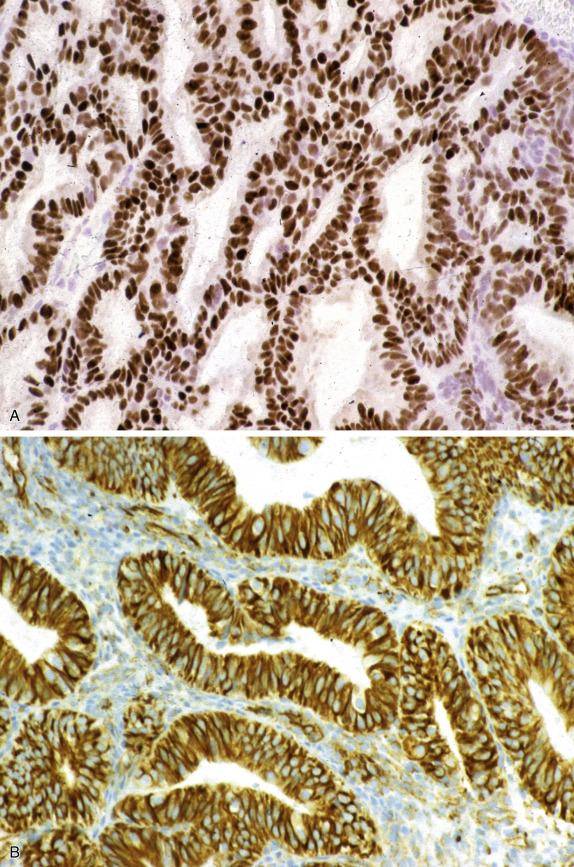
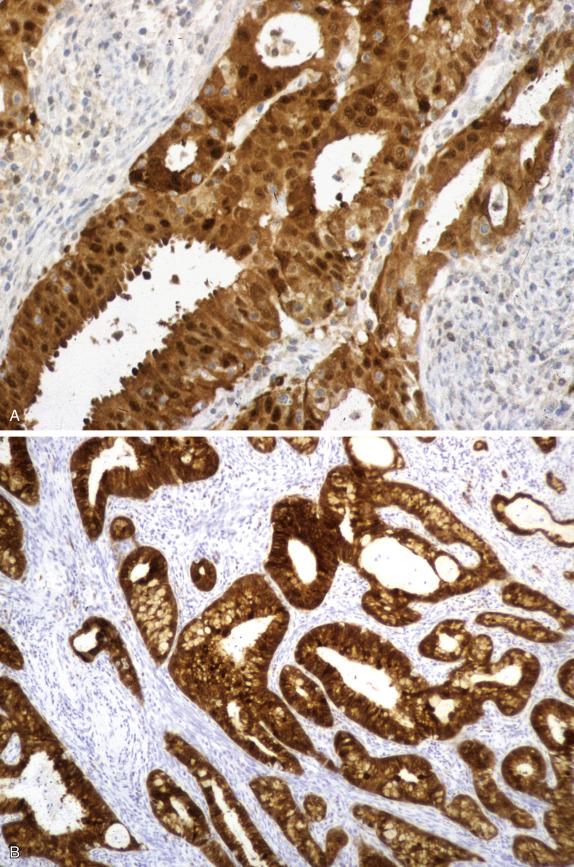
The aforementioned IHC marker does not apply to the work-up of a high-grade adenocarcinoma or undifferentiated carcinoma involving the cervix. Endometrial serous carcinoma, high-grade endometrioid, and undifferentiated carcinoma are aggressive neoplasms and not uncommonly involve the cervix. These tumors frequently show p16 overexpression (independent from HPV infection); conversely, ER expression is decreased to entirely lost (indeed, most undifferentiated carcinomas are negative for hormone receptors). In this scenario, p53 and HPV detection studies can be of value, as HPV-related endocervical adenocarcinomas are characteristically p53 normal (wild type) and positive for HPV. Nonetheless, the possibility of a poorly differentiated HPV-unrelated endocervical glandular neoplasm still needs to be excluded, in particular gastric-type endocervical adenocarcinoma.
Neuroendocrine marker expression is required for the diagnosis of large cell neuroendocrine carcinoma of the cervix; it is not required for small cell neuroendocrine carcinoma.
Chromogranin is the most specific neuroendocrine marker; synaptophysin has good sensitivity and acceptable specificity; CD56 is sensitive but lacks specificity.
p63 is typically positive in squamous carcinoma of the cervix but negative in small cell neuroendocrine carcinoma.
TTF1 is of no value in the distinction between a primary cervical and pulmonary neuroendocrine carcinoma.
Establishing a diagnosis of a neuroendocrine carcinoma of the cervix is important since these are highly aggressive neoplasms, and the management is different from other cervical carcinomas; for example, different chemotherapeutic regimens are given, and surgery is generally not undertaken even in patients with tumors confined to the cervix. However, it may be difficult to distinguish a small cell neuroendocrine carcinoma from a small cell nonkeratinizing squamous carcinoma as both neoplasms are composed of small cells with scant cytoplasm. Similarly, the distinction between a large cell neuroendocrine carcinoma and an undifferentiated carcinoma or a poorly differentiated squamous cell carcinoma or adenocarcinoma may be difficult. In problematic cases, neuroendocrine markers, such as chromogranin, synaptophysin, and CD56, may be useful. Importantly, positivity for neuroendocrine markers is not required for the diagnosis of cervical small cell neuroendocrine carcinomas as these tumors are commonly only focally positive and, in some cases, may be negative. Positive staining with neuroendocrine markers, however, is a prerequisite to diagnose a cervical large cell neuroendocrine carcinoma ( Fig. 20.13A ). Chromogranin is the most specific neuroendocrine marker, whereas synaptophysin and CD56 are the most sensitive; however, CD56 lacks specificity. Positive staining with chromogranin in cervical neuroendocrine carcinomas is often very focal with a punctate pattern of cytoplasmic immunoreactivity, which may be identified only on high-power examination. TTF1 is commonly positive, sometimes with diffuse immunoreactivity, in cervical neuroendocrine carcinomas ( Fig. 20.13B ), and this marker is of no value in the distinction between a cervical and a pulmonary primary. p63 may be of value in some cases since most squamous carcinomas are diffusely positive and neuroendocrine carcinomas, including small cell neuroendocrine carcinoma, are negative or only focally positive. p63 may also be of value in distinguishing between a poorly differentiated squamous carcinoma (usually positive) and a poorly differentiated adenocarcinoma (usually negative).
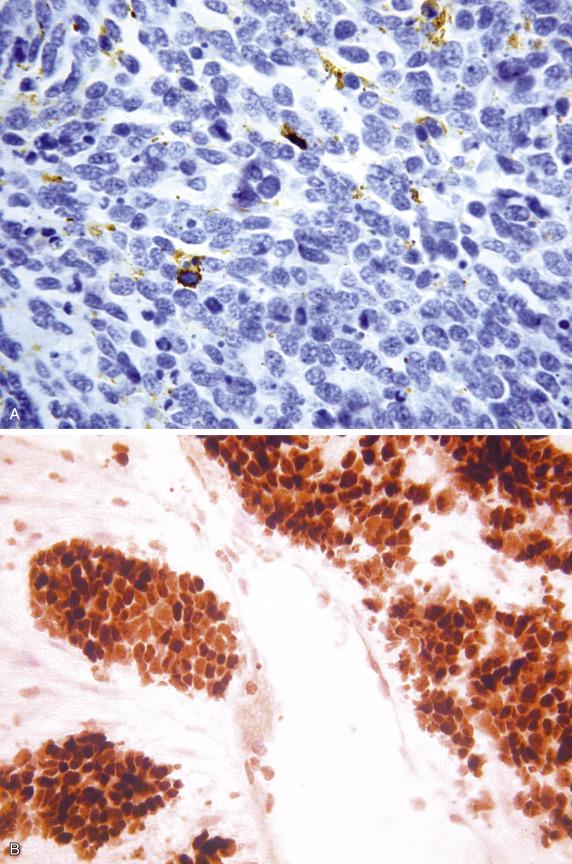
There is a spectrum of benign and rarely malignant glandular lesions involving the lower female genital tract that probably derive from misplaced Skene (periurethral) glands, the female equivalent of prostatic glands in the male. These lesions include rare Skene gland adenocarcinomas, so-called ectopic prostatic tissue in the cervix, vaginal tubulosquamous polyp, and rare microscopic vulva lesions. These lesions are positive with the prostatic markers prostate-specific antigen and prostatic acid phosphatase ( Fig. 20.14 ), although the degree of positive staining is variable and positivity is typically in the glandular component.
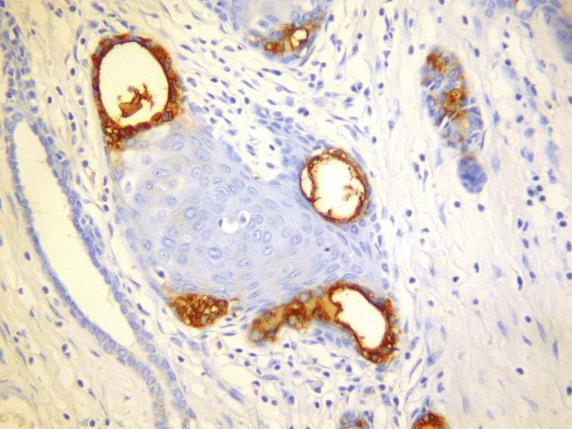
The concept of a dualistic model of endometrial carcinogenesis is well established, although it has been recently expanded and even challenged by the molecular-based classification proposals for endometrial carcinoma (see later discussion). The distinction between low-grade endometrioid carcinoma and serous carcinoma is usually straightforward, but there are exceptions. For example, many low-grade endometrioid adenocarcinomas have a papillary architecture and may be confused with serous carcinoma. Conversely, a glandular variant of serous carcinoma exists with little or no papillary formation, and this may be misdiagnosed as a low-grade endometrioid adenocarcinoma. In difficult cases, immunohistochemical staining with a panel of markers including ER, PR, p53, p16, PTEN, HMGA2, and IMP3 may assist in this distinction ( Table 20.3 ). Low-grade endometrioid carcinomas exhibit diffuse nuclear positivity for ER and PR, as well as normal p53. p16 is negative or patchy (with alternating positive and negative areas—so-called “mosaic” pattern). IMP3 and HMGA2 are usually negative or focally positive. Loss of PTEN expression is seen in a significant number of endometrioid intraepithelial neoplasia and low-grade endometrioid carcinoma, although this marker is considered by many authors as suboptimal in terms of sensitivity and specificity ( Fig. 20.15 ). In contrast, most serous carcinomas exhibit abnormal p53 staining ( Fig. 20.16A ) and p16 overexpression ( Fig. 20.16B ). They are positive for HMGA2 and IMP3 and retain PTEN expression. ER may be negative or focally or diffusely positive. PR is usually negative or only focally positive.
| Endometrioid b | Serous | |
|---|---|---|
| p53 | Normal (wild type) | Abnormal (overexpressed or completely absent) |
| ER | Diffuse positive | Negative, focal, or diffuse positive |
| PR | Diffuse positive | Negative, focal, or diffuse positive |
| PTEN | Lost or retained | Retained |
| p16 | Negative or focal positive | Diffuse positive |
| IMP3 | Negative or focal positive | Diffuse positive |
| HMGA2 | Negative or focal positive | Diffuse positive |
a The results in the table represent the most typical staining patterns, but in some cases, there are exceptions with one or more markers.
b The results listed in the table apply to low-grade endometrioid carcinoma. High-grade endometrioid adenocarcinoma may exhibit abnormal p53, loss of ER/PR, and p16 overexpression.
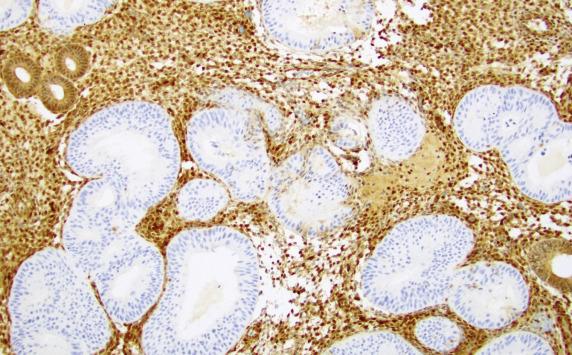
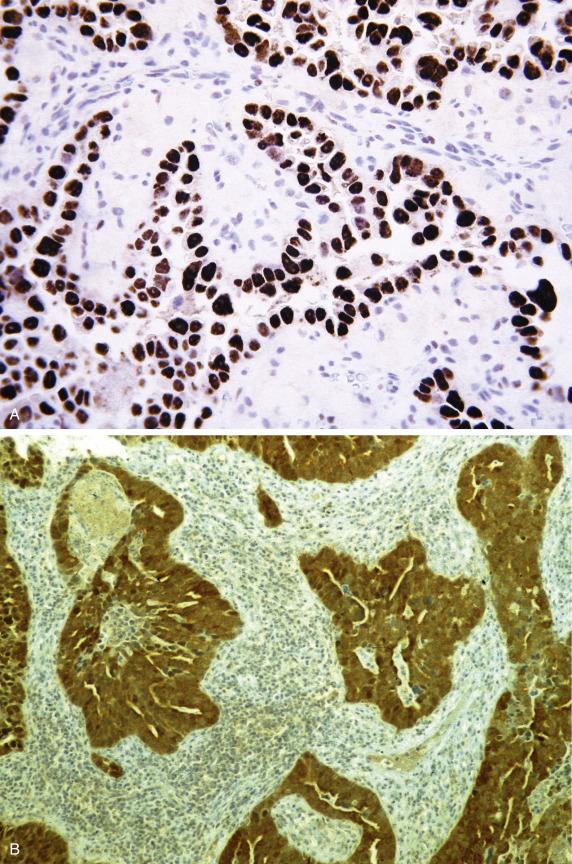
The earlier panel does not apply to high-grade endometrioid carcinomas. This category has a more heterogeneous spectrum of tumors at the immunophenotypic and molecular level that overlaps with that of serous and clear cell carcinomas. Staining for p53 is abnormal in 20%–35% of high-grade endometrioid carcinomas, and p16 is frequently overexpressed. In addition, there is significant loss of ER and PR expression. In the context of a high-grade endometrial carcinoma, a normal p53, a patchy p16, and loss of normal MMR staining are compatible with an endometrioid tumor. In any other case, the distinction should rely on morphology and, even then, cannot be achieved in a proportion of cases. Lastly, mixed endometrial carcinomas are rare, but can be encountered, and should be kept in mind when interpreting IHC results.
Clear cell carcinoma, another high-grade endometrial neoplasm, stains for Napsin-A, alpha-methylacyl-CoA racemase (AMACR), and HNF1B, the former being the most specific of the three and similarly sensitive ( Fig. 20.17 ). Importantly, the expression of Napsin-A can be focal. Endometrioid and serous carcinomas can express AMACR and HNF1B (less likely Napsin-A). Clear cell carcinoma is usually negative for ER and PR, although weak positivity can be encountered. ∼35% of cases show p53 abnormalities, and p16 is negative or patchy positive. If the diagnosis of clear cell carcinoma is being entertained, a panel including Napsin-A, ER/PR, and p53 is helpful, keeping in mind that overlap with serous and endometrioid carcinomas exists and that IHC may not be contributory.
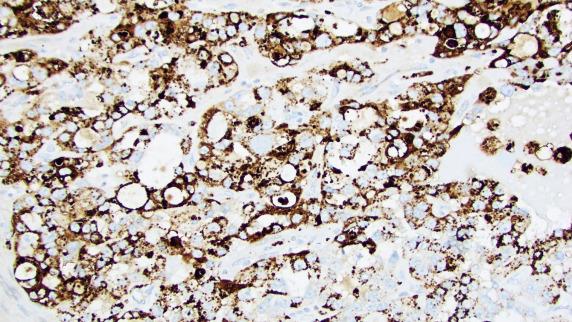
The entity of undifferentiated endometrial carcinoma has gained increasing attention in the literature. It may occur in pure form or in combination with a low-grade (grade 1 or 2) endometrioid adenocarcinoma (dedifferentiated adenocarcinoma). Undifferentiated carcinomas can be positive for epithelial markers (CK8/18, EMA, pancytokeratin), although in most cases it will be patchy or focal ( Fig. 20.18 ). Even if the staining is focal, it is characteristically strong, and this may be of use diagnostically and in the distinction from other neoplasms such as high-grade endometrioid adenocarcinoma (diffuse expression) or undifferentiated uterine sarcoma (negative). Hormone receptors and PAX8 are negative in most cases. Of note, these tumors can be positive for cyclin D1 (which is a pitfall in the differential diagnosis with high-grade endometrial stromal sarcoma [HG-ESS]).
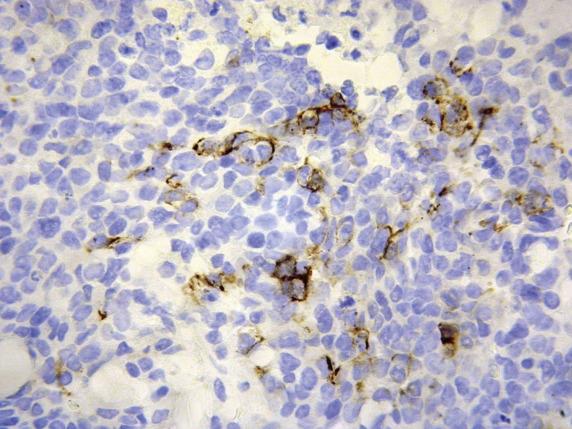
In general, immunohistochemistry is of limited value in the diagnosis of carcinosarcoma since a malignant epithelial and mesenchymal component should be seen on morphologic examination. However, immunohistochemistry may be useful in confirming the presence of a heterologuous mesenchymal component. Positive nuclear staining with myogenin and MyoD1 helps to confirm rhabdomyoblastic differentiation, and S100 positivity may help support liposarcomatous or chondrosarcomatous differentiation. Similar comments pertain to the identification of rhabdomyoblastic differentiation in high-grade adenosarcoma, especially in areas of sarcomatous overgrowth.
The Cancer Genome Atlas (TCGA) characterized the molecular landscape of a large cohort of endometrioid, serous and mixed endometrial carcinomas and proposed a classification based on the genomic profile that correlates with patient outcome. The application of this molecular-based classification into the routine histopathologic interpretation of endometrial cancer is still at its early stages. However, it is foreseeable that ancillary testing to determine the molecular group will become part of the routine work-up. To this end, the Proactive Molecular Risk Classifier for Endometrial Cancer (ProMisE) algorithm has been recently proposed ( Fig. 20.19 ). The algorithm includes:
Immunohistochemistry for p53: interpreted as normal (wild type) or abnormal (overexpressed or null)
Immunohistochemistry for mismatch repair (MMR) proteins: interpreted as retained (normal) or deficient (abnormal) ( Fig. 20.20A,B )
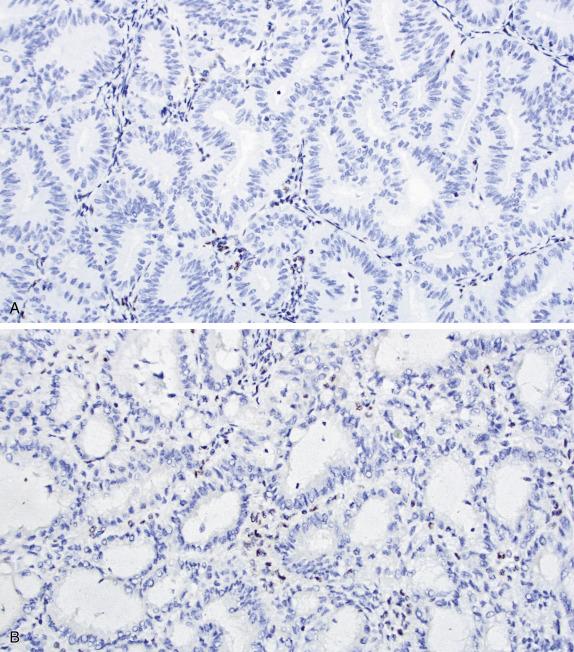
Targeted sequencing of the POLE exonuclease domain (exons 9–14)
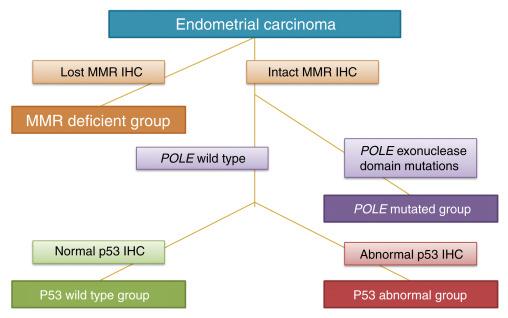
The ProMisE method was developed and validated to serve as analogous to molecular testing and has equal correlation with patient outcome (overall, disease-specific, and progression-free survival). Ancillary testing for p53 and MMR is already performed in most pathology laboratories. POLE sequencing is not; however, the need for molecular classification to be included in routine clinical practice will likely increase its demand in the future.
Low-grade endometrial carcinoma (low-grade endometrioid, mucinous)
ER/PR diffusely positive
p16 negative/patchy
p53 normal
Napsin-A negative
PTEN loss
High-grade endometrial carcinoma:
Serous carcinoma:
p53 abnormal
p16 overexpressed
ER/PR weakly positive
HMGA2 and IMP3 positive
Napsin-A negative
Clear cell carcinoma:
Napsin-A, AMACR, and HNF-B positive
ER and PR negative
p53 normal (∼65%) or abnormal (∼35%)
p16 negative/patchy
High-grade endometrioid carcinoma:
ER/PR: negative or weakly positive
p53 normal (∼70%) or abnormal (∼30%)
p16: patchy or overexpressed
Napsin-A: negative
Undifferentiated carcinoma:
Positive for pancytokeratins, CK8/18, and EMA (often patchy, sometimes diffuse)
Negative for PAX8, ER, and PR
Positive for cyclin D1
MMR deficient
Abnormal MMR expression
Corresponds to hypermutated (microsatellite unstable) molecular group (TCGA)
POLE mutated
POLE mutations, normal MMR
Corresponds to ultramutated molecular group (TCGA)
p53 abnormal
Abnormal p53 expression, normal MMR, negative for POLE mutations
Corresponds to Copy Number High molecular group (TCGA)
p53 wild type
Normal p53 and MMR expression, negative for POLE mutations
Corresponds to Copy Number Low molecular group (TCGA)
When disseminated serous carcinoma involves the uterus and extrauterine sites, such as the ovary and fallopian tube, it may be difficult to ascertain the primary site of origin. Occasionally, a serous carcinoma in the endometrium may be associated with a concurrent serous tubal intraepithelial carcinoma (STIC); in such cases, it may be impossible on morphology alone to ascertain whether these represent independent primary lesions or a metastasis from one site to the other. Immunohistochemical staining with an antibody against the N-terminal of WT1 may assist in this distinction. Most upper genital (tubal, ovarian, primary peritoneal) high-grade serous carcinomas exhibit nuclear positivity with WT1, which is usually diffuse but occasionally focal (approximately 5% are negative) ( Fig. 20.21 ). Conversely most, but not all, endometrial serous carcinomas are negative or only focally WT1-positive; therefore, diffuse nuclear WT1 positivity argues against a uterine primary. There is some immunohistochemical overlap since, as discussed, a small proportion of tubo-ovarian high-grade serous carcinomas are WT1-negative, whereas some endometrial tumors exhibit focal or even diffuse positivity; of note, WT1 expression is more frequently expressed in serous carcinomas involving endometrial polyps. Thus, the results of WT1 staining should always be correlated with the clinical, morphologic, and radiologic features. p53 staining may also assist in problematic cases: if there are different patterns of “mutation-type” staining in the uterine and extrauterine lesions, the possibility of independent synchronous neoplasms can be raised.
WT1 (antibody against N-terminal):
Tubo-ovarian high-grade serous carcinoma: diffusely positive (a minority are patchy or negative)
Endometrial serous carcinoma: negative or focally positive
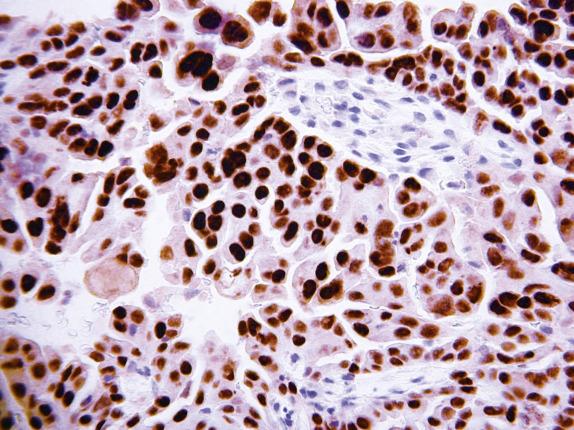
Become a Clinical Tree membership for Full access and enjoy Unlimited articles
If you are a member. Log in here